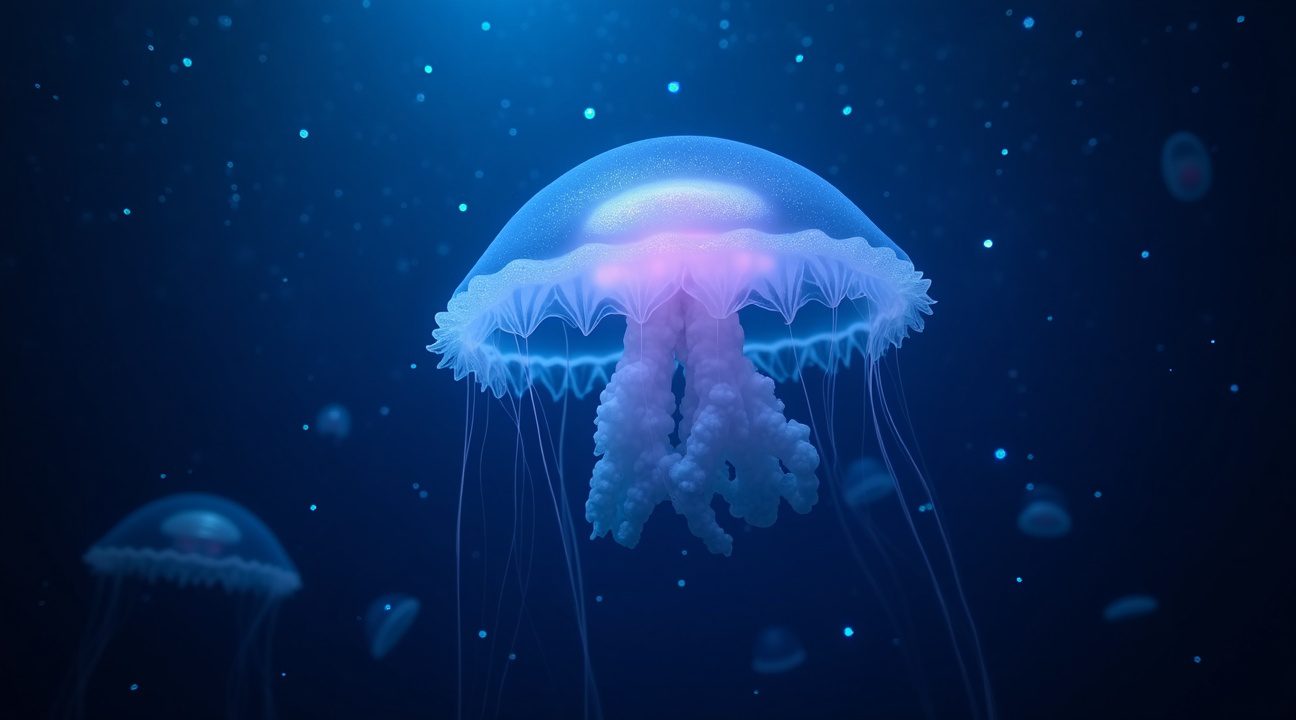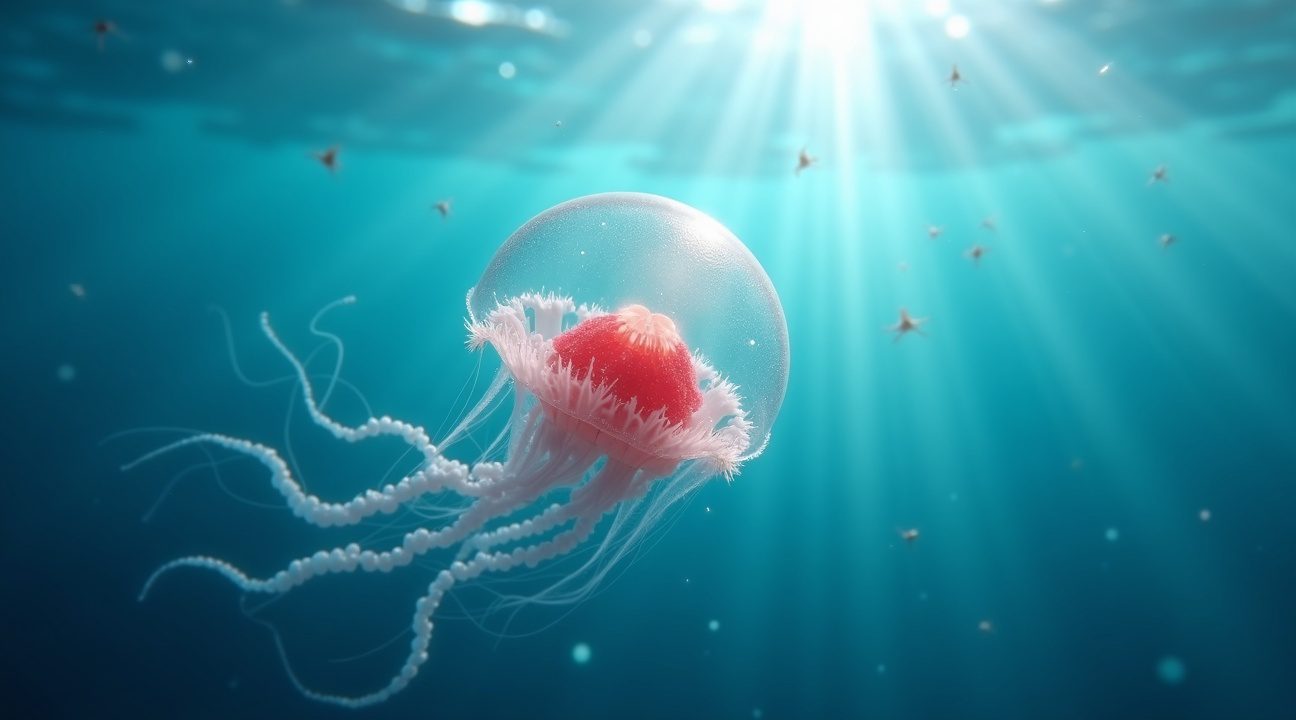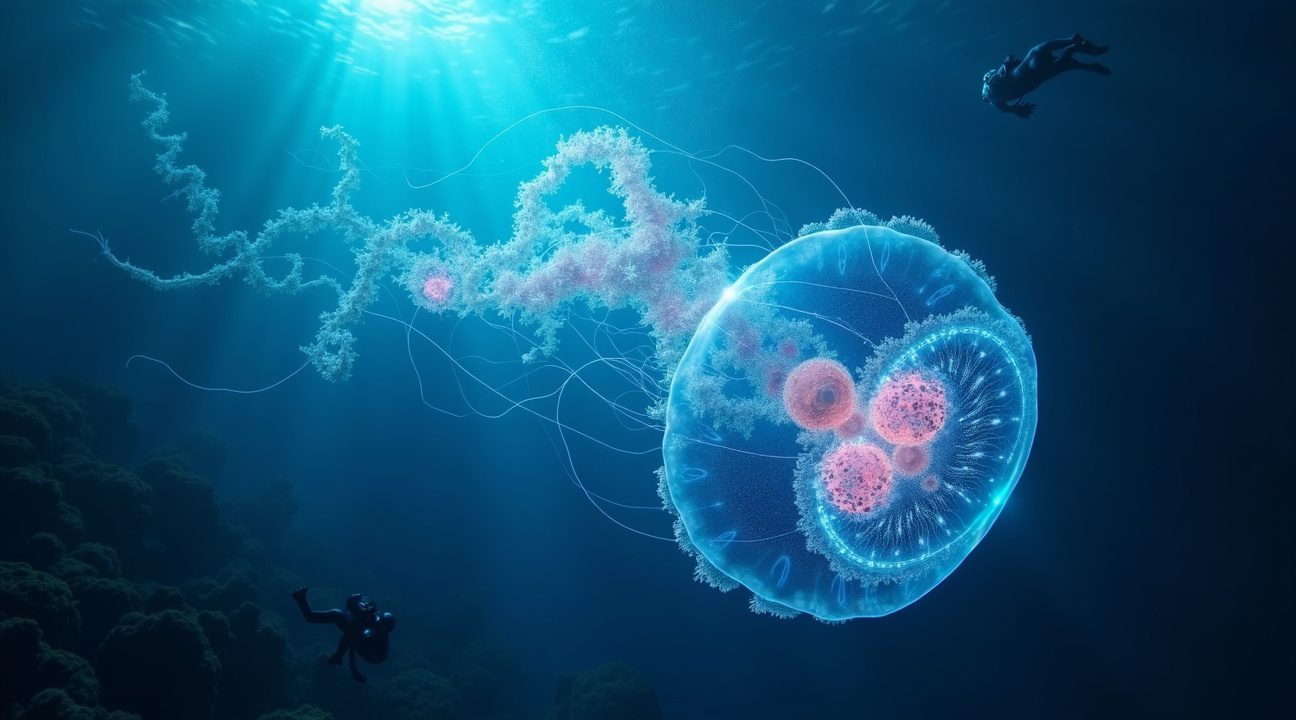The immortal jellyfish Turritopsis dohrnii has achieved what no other known animal can: it can reverse its aging process and return to its juvenile form, potentially allowing it to bypass death entirely.
Key Takeaways
- Turritopsis dohrnii can reverse its entire life cycle when exposed to stress, aging, or injury, transforming from an adult medusa back into a juvenile polyp through cellular reprogramming.
- The process involves transdifferentiation, in which specialized cells convert into different types, resetting the jellyfish’s biological age to zero within 24–72 hours.
- Although considered biologically immortal, most specimens succumb to external threats like predators, disease, and environmental factors before repeating this regeneration multiple times.
- This jellyfish has unique genetic traits such as enhanced DNA repair abilities, superior telomere maintenance, and amplified pluripotency genes that set it apart from other mortal jellyfish species.
- Scientific research on this organism could lead to breakthroughs in human regenerative medicine, anti-aging therapies, and treatments for degenerative diseases, though such applications are still in nascent stages.
Further Learning
To learn more about the biological mechanisms behind this fascinating creature, visit the Turritopsis dohrnii Wikipedia page for in-depth insights.
Meet the Jellyfish That Cheats Death by Aging Backwards
I’ve studied countless marine species throughout my career, but Turritopsis dohrnii stands out as perhaps the most extraordinary creature in our oceans. This small jellyfish has earned the nickname “immortal jellyfish” for a remarkable ability that defies everything we understand about aging and death in the animal kingdom.
Most hydrozoans follow a predictable life cycle. They begin as polyps attached to surfaces, transform into free-swimming medusae, reach sexual maturity, reproduce, and die. Turritopsis dohrnii breaks this fundamental biological rule by performing what scientists call life cycle reversal. After reaching sexual maturity and releasing gametes, this jellyfish can actually revert back to its juvenile polyp stage rather than dying.
The process resembles hitting a biological reset button. The adult medusa settles to the ocean floor, its bell-shaped body contracts, and its tentacles are reabsorbed. Through a process called transdifferentiation, the jellyfish’s cells literally transform into different cell types, rebuilding the organism as a polyp. From this juvenile stage, it can grow back into an adult medusa and potentially repeat the cycle indefinitely.
The Reality Behind Biological Immortality
Scientists classify this phenomenon as biological immortality because the jellyfish theoretically has no maximum natural lifespan. Unlike humans and most animals that experience cellular degradation over time, Turritopsis dohrnii can essentially restart its biological clock whenever environmental stress or aging threatens its survival. Recent advances in robotics have even drawn inspiration from such remarkable transformative abilities found in nature.
However, I should clarify that “immortal” doesn’t mean invincible. These jellyfish face the same threats as any marine organism:
- Predators still consume them
- Diseases can kill them
- Environmental toxins pose lethal risks
The vast majority of immortal jellyfish die from these external factors long before they have a chance to demonstrate their age-reversing abilities multiple times.
Research on Turritopsis dohrnii has captured scientists’ attention because it challenges our fundamental understanding of aging and death. The jellyfish’s ability to reverse its developmental process could potentially offer insights into cellular regeneration and longevity research. While we’re far from applying these mechanisms to other organisms, studying how this tiny jellyfish accomplishes something no other known animal can do continues to yield fascinating discoveries about the flexibility of biological systems.
The immortal jellyfish proves that nature still holds secrets that can fundamentally reshape our understanding of life itself.

How Cellular Time Travel Actually Works
The immortal jellyfish’s extraordinary ability stems from a process called transdifferentiation, where specialized cells transform into entirely different cell types. This cellular metamorphosis allows the organism to literally reverse its aging process, reforming its tissues as it returns to the polyp stage from its adult medusa form.
When faced with environmental stress, physical damage, starvation, or the natural progression of old age, adult medusae trigger this remarkable survival mechanism. The jellyfish forms a protective cyst structure that serves as a biological cocoon for its transformation. Within just 24 to 72 hours, this cyst morphs back into a juvenile polyp, essentially hitting the reset button on the creature’s entire life cycle.
The Science Behind Life Cycle Reversal
Life cycle reversal (LCR) operates through sophisticated cellular reprogramming mechanisms that scientists are still working to fully understand. During this process, the jellyfish activates pluripotency genes — the same genetic switches that allow stem cells to become any type of cell in the body. Simultaneously, it silences PRC2 targets, which are proteins that typically maintain cellular identity and prevent unwanted changes.
This cellular reprogramming represents one of nature’s most advanced rejuvenation strategies. Unlike typical aging processes where cells gradually lose function and die, the immortal jellyfish can command its cells to abandon their specialized roles and return to a more primitive, flexible state. The transformation affects every aspect of the organism’s biology, from its nervous system to its digestive structures.
Scientists have observed that this remarkable process doesn’t just pause aging – it completely reverses it. The reformed polyp possesses all the characteristics of a young organism, ready to grow and develop once again into a mature medusa. This cycle can theoretically repeat indefinitely, making cellular transformation a subject of intense scientific interest.
The implications of understanding transdifferentiation extend far beyond marine biology. Researchers believe that unlocking the secrets of the immortal jellyfish’s cellular time travel could revolutionize approaches to aging, regenerative medicine, and tissue repair in other organisms. The jellyfish’s ability to reprogram its cells on command represents a biological phenomenon that challenges our fundamental understanding of life cycles and mortality.

The Complete Life Cycle of Biological Immortality
The immortal jellyfish’s life cycle represents one of nature’s most extraordinary achievements — a complete reversal of the aging process that challenges everything I know about mortality in the animal kingdom. This tiny marine creature has mastered the art of turning back time, cycling through distinct developmental stages in a pattern that can theoretically continue forever.
The Forward Journey: From Larva to Adult
The journey begins with the planula, a microscopic larval stage that drifts freely through ocean currents. This tiny, elongated larva eventually settles on a hard surface and transforms into an attached polyp colony. These polyps don’t remain isolated — they create branching colonies through asexual reproduction, producing genetically identical copies of themselves that spread across the seafloor like underwater gardens.
From these polyp colonies emerge the free-swimming medusa, the familiar bell-shaped form that most people recognize as a jellyfish. These adult medusae can reproduce sexually, creating new planula larvae that will start the cycle anew. However, what makes this species truly remarkable isn’t this conventional forward progression — it’s what happens next.
The Reverse Miracle: Adult to Juvenile Transformation
When faced with physical damage, starvation, old age, or other stressful conditions, adult medusae can reverse their development completely. The mature jellyfish doesn’t simply die — it transforms back into a polyp colony, essentially rewinding its biological clock to an earlier stage of life. This process involves the reabsorption of the bell and tentacles, followed by the reorganization of cellular structures.
Scientists have documented this life cycle reversal happening repeatedly in laboratory conditions. Each time the organism completes this transformation, it maintains the same genetic makeup as its previous incarnation. The polyp colony that emerges from reverse development then begins producing new medusae through budding, continuing the pattern indefinitely.
This asexual reproduction during the polyp stage ensures genetic consistency across generations. Unlike sexual reproduction, which creates genetic variation, the budding process produces identical copies. This means that each new medusa carries the exact same DNA as its predecessors, creating what’s essentially a series of genetic clones with unlimited regenerative potential.
The implications of this biological process extend far beyond marine biology. While most organisms follow a linear path from birth to death, the immortal jellyfish has essentially solved the problem of aging by refusing to accept it as permanent. Much like how advanced technology can adapt and transform under pressure, this creature has evolved an incredible escape mechanism from mortality itself.
Every cycle maintains perfect cellular integrity, allowing the organism to avoid the accumulation of damage that typically leads to death in other species. The polyp stage acts as a biological reset button, clearing away the wear and tear of adult life and restoring the organism to a pristine juvenile state.
This remarkable adaptation has captured the attention of researchers worldwide who study aging and regeneration. The immortal jellyfish demonstrates that biological immortality isn’t just theoretical — it’s a reality that exists in our oceans today. Through its unique ability to reverse the aging process, this small creature has achieved what humans have dreamed about for millennia: the conquest of death through biological means.
The continuous cycling between medusa and polyp stages creates an endless loop of renewal. Each transformation represents not just survival, but a complete cellular rebirth that maintains the organism’s original genetic integrity while resetting its biological age to zero.
A Tiny Transparent Wonder Conquering the World’s Oceans
I find it remarkable that something so small can achieve biological immortality. Turritopsis dohrnii measures just 4.5 to 5 millimeters in diameter when fully grown—smaller than a pinky nail. This diminutive size makes it easy to overlook, yet this creature possesses one of nature’s most extraordinary abilities.
Physical Characteristics That Define a Marvel
The immortal jellyfish displays a distinctive transparent bell that houses a bright red stomach at its center. Up to 90 white tentacles line the edge of the bell, creating an almost ethereal appearance as it drifts through the water. This transparent bell allows observers to see directly through the creature, making the vibrant red stomach particularly striking against the clear backdrop. The tentacles serve a dual purpose, functioning both as feeding apparatus and sensory organs that help the jellyfish navigate its aquatic environment.
Global Distribution Through Human Activity
Originally described in the Mediterranean Sea, T. dohrnii has now spread to temperate and tropical oceans worldwide. Scientists attribute this global distribution primarily to ballast water carried by cargo ships. When vessels take on water for stability in one port and discharge it in another, they inadvertently transport marine organisms across vast distances. This process has transformed the immortal jellyfish from a regional species into a cosmopolitan wanderer.
The species now thrives in diverse marine environments, from the warm waters of the Caribbean to the cooler seas around Japan. I observe that this widespread distribution has actually aided scientific research, as researchers can now study these creatures in multiple locations rather than traveling exclusively to the Mediterranean.
The immortal jellyfish maintains a simple diet, primarily consuming plankton and fish eggs. It filters these tiny organisms through its tentacles while floating near the water’s surface. This feeding strategy positions the jellyfish in productive surface waters where plankton concentrations are highest. The creature’s small size means it requires relatively few resources to sustain itself, contributing to its success in colonizing new habitats.
This unassuming appearance masks one of biology’s most fascinating phenomena. While other marine creatures face the inevitable decline of aging, the immortal jellyfish has discovered a way to reset its biological clock entirely. Much like how robots can transform their physical state, this jellyfish can completely reorganize its cellular structure when faced with stress or aging.

The Genetic Secrets Behind Eternal Youth
I find the genetic foundation behind Turritopsis dohrnii‘s immortality fascinating, as recent genomic studies have revealed extraordinary molecular mechanisms that allow this jellyfish to achieve what scientists once thought impossible. The creature possesses unique genetic amplifications and variants that set it apart from every other known organism on Earth.
DNA repair mechanisms in T. dohrnii operate at levels far beyond those found in typical marine organisms. Scientists have discovered that this species carries enhanced versions of genes responsible for fixing cellular damage, allowing it to maintain genetic integrity throughout countless cycles of regeneration. These amplified repair pathways work continuously to prevent the accumulation of mutations that normally lead to aging and death in other species.
Telomere maintenance represents another crucial component of the immortal jellyfish’s genetic arsenal. While most organisms experience telomere shortening with age, T. dohrnii maintains these protective chromosome caps through specialized enzymatic processes. This preservation prevents the cellular senescence that typically occurs when telomeres become critically short, effectively stopping one of the primary drivers of aging at its source.
Comparative Analysis with Mortal Relatives
Comparative genomics with Turritopsis rubra, a closely related but mortal species, provides compelling evidence for the genetic basis of immortality. Scientists have found that T. rubra lacks the specific genetic variants present in T. dohrnii, particularly those related to cellular senescence resistance and intercellular communication pathways. This comparison highlights how even small genetic differences can result in dramatically different aging outcomes.
The absence of rejuvenation capabilities in T. rubra at mature stages demonstrates that immortality isn’t simply a jellyfish trait but rather a unique evolutionary adaptation.
Key differences include:
- Variations in genes controlling pluripotency – the ability of cells to return to an undifferentiated state capable of becoming any cell type
- Enhanced pluripotency genes in T. dohrnii that allow mature cells to reverse their developmental clock
PRC2 complex regulation also differs significantly between these species. This protein complex controls gene expression patterns during development and cellular reprogramming. In T. dohrnii, modifications to PRC2-related pathways enable the coordinated shutdown and restart of developmental programs necessary for reverse aging. The enhanced intercellular communication systems in the immortal species coordinate this complex process across the entire organism.
Research into cellular senescence pathways reveals that T. dohrnii has evolved mechanisms to bypass the normal cellular aging process entirely. While most cells eventually stop dividing and enter a senescent state, this jellyfish maintains cellular function indefinitely through genetic variants that prevent senescence signals from taking hold.
The discovery of these genetic secrets has profound implications for understanding aging across species. Scientists studying biological transformations continue to explore how these mechanisms might apply to other organisms. The immortal jellyfish’s genetic toolkit provides a blueprint for biological immortality that challenges conventional understanding of life cycles and aging processes.
Gene expression patterns in T. dohrnii show remarkable flexibility compared to other cnidarians. The creature can activate embryonic development programs while simultaneously maintaining adult cellular functions, creating a unique biological state that defies traditional developmental biology. This genetic plasticity underlies the jellyfish’s ability to repeatedly cycle between life stages without losing viability or accumulating age-related damage.
What Immortal Jellyfish Mean for Human Medicine and Aging Research
Scientists are studying Turritopsis dohrnii‘s extraordinary cellular and genetic mechanisms to unlock potential breakthroughs in aging research and regenerative medicine. The jellyfish’s ability to reverse its biological clock has captured the attention of researchers working on human longevity and age-related diseases.
The cellular reprogramming process that allows T. dohrnii to transform from adult back to juvenile involves complex genetic switches that researchers believe could hold keys to understanding biological longevity in humans. During this transformation, the jellyfish essentially resets its cellular age, converting specialized adult cells back into stem cells that can develop into any tissue type. This process, called transdifferentiation, represents a biological phenomenon that medical researchers are eager to understand and potentially replicate.
Research Applications in Regenerative Medicine
Current studies focus on several promising areas where immortal jellyfish research might benefit human health:
- Tissue regeneration techniques that could help repair damaged organs and tissues
- Anti-aging therapies that target cellular degradation and DNA damage
- Cancer research, since the jellyfish’s cellular transformation shares similarities with tumor cell behavior
- Stem cell research that could advance treatments for degenerative diseases
- Drug development focused on extending healthy human lifespan
However, the reality of biological immortality differs significantly from the laboratory findings. Most T. dohrnii specimens in their natural habitat don’t achieve immortality due to mortality risks including predation, disease, and environmental hazards. Larger fish, sea turtles, and other marine predators consume these small jellyfish before they can complete multiple life cycles. Ocean pollution, temperature changes, and habitat destruction also contribute to their mortality in wild populations.
Recent technological advances in cellular biology have allowed researchers to observe the jellyfish’s transformation process in greater detail. Understanding why these creatures can avoid the typical aging process while humans cannot has become a priority for aging research initiatives worldwide.
The genetic mechanisms that enable T. dohrnii‘s regenerative abilities operate differently than human cellular repair systems. While humans possess some regenerative capacity, particularly in liver tissue and wound healing, the complete cellular reprogramming seen in immortal jellyfish remains beyond current human biology. Researchers continue investigating whether specific genes or proteins from these jellyfish could be adapted to enhance human regenerative medicine applications.
Environmental factors that limit the jellyfish’s practical immortality in nature provide important context for understanding biological longevity. Even with perfect cellular repair mechanisms, external threats remain significant challenges that no amount of genetic programming can completely overcome.

Sources:
Wikipedia, “Turritopsis dohrnii”
PNAS, “Comparative genomics of mortal and immortal cnidarians…”
Cape Clasp Blog, “Immortal Jellyfish”
PMC, “Cellular Reprogramming and Immortality: Expression Profiling …”
American Museum of Natural History Blog, “The ‘Immortal’ Jellyfish That Resets When Damaged”
BBC Science Focus, “The secrets of the immortal jellyfish, Earth’s longest-living animal”
HowStuffWorks, “Does the Immortal Jellyfish Actually Live Forever?”
Immortal-Jellyfish.com, “Immortal Jellyfish – Lifespan, Life Cycle and Facts”


